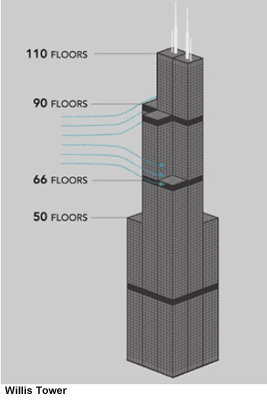 If you get motion sickness, don’t go to the 108-story Willis (Sears) Tower in Chicago on a windy day. The building sways so much that, not only will you get motion sickness, the elevator that you are riding in might get shut down or stuck in the shaft until the wind subsides. This, according to Justin McGar in a recent posting in Sourceable, is but an indicator of the design and engineering issues related to tall towers and the elements.
If you get motion sickness, don’t go to the 108-story Willis (Sears) Tower in Chicago on a windy day. The building sways so much that, not only will you get motion sickness, the elevator that you are riding in might get shut down or stuck in the shaft until the wind subsides. This, according to Justin McGar in a recent posting in Sourceable, is but an indicator of the design and engineering issues related to tall towers and the elements.
There are a wide variety of solutions that engineers apply to the newer designs for motion damping, including the use of stiffening or core design or mass and tuned liquid dampers that quiet the motion by acting as a counter balance to the pressures and motion of the wind.
Other buildings can induce added motion for buildings by creating a vortex that increases the speed of the wind as it hits the buildings around it. Proximity becomes a factor especially when tall buildings are clustered in cities like Chicago where wind is a constant.
One of the most important professionals involved in the design team for tall buildings has become the wind engineer. For the tall buildings being built these days, wind-engineers work side-by-side with the architects to tweak designs in order to counter the wind effects and reduce the sway, and ultimately, reduce the cost of those systems and the core and shell of the buildings.
Several new techniques are to be included in the design for some of the tallest towers, but the current tallest, the Burj Khalifa Tower used an aerodynamic design to solve the sway issue and avoid some of the more expensive solutions.


